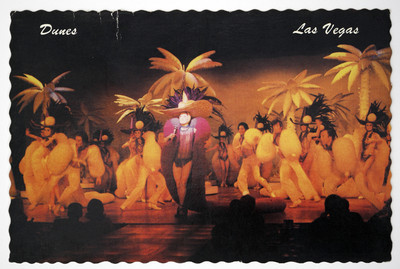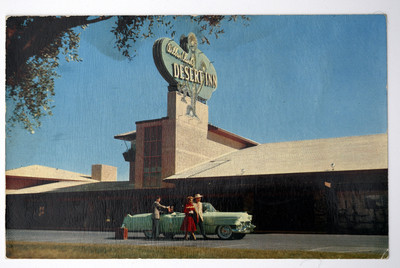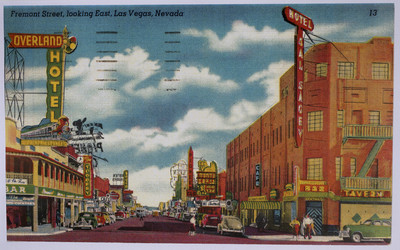POSTCARDS FROM PARADISE
Flipping through Carey Burke's 1,200-plus postcard collection is like taking a Las Vegas history class. And there's even a pop quiz.
There's the Strip when it was nothing more than a dusty desert road; turn the page and you'll see a couple of postcards of the Thunderbird Downs racetrack in the 1960s. (Did you even know Las Vegas was once home to two horse tracks?)
The history lesson goes on for pages, featuring postcards of every hotel in various forms: The Dunes, Tropicana, Castaways, Pioneer, Caesars Palace and many others.
There's a postcard featuring an artist's rendering of Hoover Dam, before it was built.
"Where are the (dam's) spillways?" Burke asks, pointing to two white structures on the right side of the card. "This was a mistake, there's a spillway on either side, not two on one side."
Burke has been collecting local postcards since he was a kid growing up in Las Vegas. He has a lot, he says, but his collection is only a fraction of the Las Vegas postcards published over the years.
"The face of hotels and the Strip has changed dozens of times and there's a postcard for every change," Burke notes.
But what's for sale on the racks has less to do with the popularity of a certain attraction and more to do with the availability of an image, says postcard photographer David Aillo.
Visit any gift shop and you'll see, the postcards look much the same. There are postcards featuring individual hotels or a collage of several; aerial shots of the Strip at day and night; postcards of the Fremont Street Experience; the "Welcome to Fabulous Las Vegas" sign; and many others.
Publishers usually print a collection of postcards instead of a single one, Aillo says, but they have to obtain the rights to use images of casinos, because they're private property. As a result, many of those found in local gift shops feature images that are generic or of artifacts that are no longer copyright protected, he adds. That's why there are so many aerial shots of the Strip.
Often a casino contracts its own series of postcards.
It's hard to name the most popular Las Vegas postcards because there are so many and they change so often, say local gift shop managers.
The ABC Store at the Fremont Street Experience sells 1,000 to 2,000 postcards a month, says William, the assistant manager. The most popular is a shot of the Strip taken from the MGM Grand.
"They change all the time, because the skyline changes all the time," says Lynn Morris, owner of Bonanza Gifts Shop. Postcards featuring the "Welcome to Fabulous Las Vegas" sign seem to be popular now, she adds.
Aillo, who has had as many as 80 postcards in a year and as few as 12, has received the most requests for the Fountains at Bellagio.
Why?
"Probably because they're so difficult to shoot," he explains.
Which illustrates one of the reasons people buy a postcard: "It's a picture they can't take," says Anne Kellogg, owner of Paperdoll Stationery Boutique.
"I think people buy postcards for two reasons. First, it's to act as a snapshot of your trip, so you can use them in your scrapbook," Kellogg says. "Second, is to send them, jot down a note to say, 'See you soon.' That's all changing because now you can send picture and message by cell phone. But to me, there's still something special about receiving a postcard."
Bob Stoldal, local postcard collector and historian, says there are three reasons people buy postcards:
"You stayed there, you would have liked to have stayed there or it's unusual," he says.
Contact reporter Sonya Padgett at spadgett@reviewjournal.com or (702) 380-4564.
POSTCARDS THROUGH THE YEARS Today, postcards feature mostly photos of Las Vegas, the Strip and area landmarks. But early Las Vegas postcards were paintings of a subject and, up until the beginning of World War II, they were made of linen. The postcard in general has gone through several eras since it first caught on in mid-19th century America, says local urban historian Brian Paco Alvarez. The first was the pioneer era, around 1893. That's when postcards appeared at Chicago's Columbian Exposition. A few years later, the words "post card" were printed on them and people could actually mail them. "In the period when Las Vegas came into being, your household would likely have a postcard album as an entertainment vehicle," says Bob Stoldal, a local collector and historian. In 1905, when Las Vegas was founded as a city, you couldn't write on the back of a postcard, Stoldal says. The postal service wanted only a stamp and an address. "You'd have to write on the corner, they'd give you just an inch," Stoldal says. Finally, a line appeared on the backs of postcards in 1907, with one half reserved for the stamp and address and the other for the message. Over the years, postcards have been made out of leather, wood and metal. Some even featured glitter, Stoldal says, until they started jamming postal equipment. Now, postcards come in a variety of sizes, the traditional 3 by 5 inch; 4 by 6 inch and 8 by 5 inch. Up until the 1920s, Las Vegas postcards were published by local drugstores, says Stoldal, who is writing a book on the subject. Many of the high-quality linen postcards were published in Germany and Ireland. Contemporary postcards are published in China. Publishers rarely assign a photographer to shoot a subject, says postcard photographer David Aillo, because they buy their images from stock agencies. The cost of mailing a postcard was originally 1 cent, hence the term "penny postcard." Currently, it costs 26 cents to mail a traditional postcard and 41 cents to send anything more than 6 inches long.























